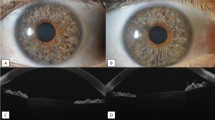Summary
PES has been associated with weakness of zonular attachments to the ciliary body and with late dislocation of the IOL following cataract extraction with in-the-bag IOL implantation. We evaluated the frequency of PES in patients with IOL dislocation following phacoemulsification cataract surgery.
Patients and methods: We retrospectively reviewed the records of five patients who had undergone phacoemulsification, followed by implantation of a posterior chamber IOL in the capsular bag during the years 1992 through 1996 and who showed IOL dislocation during follow-up. We looked for clinical signs of PES that had been noted prior to or after IOL dislocation.
Results: Detailed review of the records of these patients identified PES as a coexistent condition in all five. The most impressive clinical feature was shrinkage of the capsular bag to conform to the size and contour of the implanted IOL.
Conclusions: In accordance with many histopathological and clinical studies supporting our findings, we suggest that shrinkage of the capsular bag can be reduced by not using foldable IOL, by early anterior YAG capsulotomy or by the use of an IOL with a larger optic.
Hintergrund: Das Pseudoexfoliationssyndrom (PEX) führt zu einer Insuffizienz des kapsulären Aufhängeapparates. Ziel dieser Arbeit war es herauszufinden, wie häufig bei einer späten Luxation des Kapselsackes infolge Zonulolyse ein PEX zu finden war.
Patienten und Methode: In dieser retrospektiven Studie sahen wir in einem Zeitraum von 4 Jahren an unserer Klinik eine späte Spontanluxation bei 5 endokapsulär implantierten Intraokularlinsen (IOL) mit intaktem, geschrumpftem Kapselsack.
Ergebnisse: Die komplikationslose Kataraktextraktion erfolgte durch Phakoemulsifikation. Prä- und intraoperativ war keine Phakodonesis vermerkt. Alle Augen zeigten die typischen Merkmale eines PEX. Besonders auffallend war in allen Fällen eine Schrumpfung des Kapselsackes, welche den Konturen des Linsendesigns folgte.
Schlußfolgerung: In Übereinstimmung mit den meisten klinischen und histopathologischen Studien sind wir der Meinung, daß das später auftretende erhöhte Zonulolyserisiko beim PEX nach Phakoemulsifikation bei der operativen Planung berücksichtigt werden sollte. Lösungsansätze hierfür wären der Verzicht auf faltbare IOL, die Durchführung einer frühen anterioren YAG-Kapsulotomie und die Verwendung von IOL mit größerem Optikdurchmesser.
Similar content being viewed by others
Author information
Authors and Affiliations
Rights and permissions
About this article
Cite this article
Breyer, D., Hermeking, H. & Gerke, E. Late dislocation of the capsular bag after phacoemulsification with intraocular lens implantation in pseudoexfoliation syndrome (PES). Ophthalmologe 96, 248–251 (1999). https://doi.org/10.1007/s003470050400
Issue Date:
DOI: https://doi.org/10.1007/s003470050400




